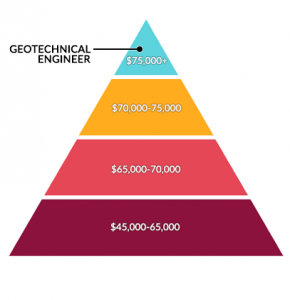8 Easy Facts About Geotheta Explained
8 Easy Facts About Geotheta Explained
Blog Article
The Only Guide to Geotheta
Table of ContentsThe 5-Minute Rule for GeothetaThe smart Trick of Geotheta That Nobody is Talking AboutUnknown Facts About GeothetaLittle Known Facts About Geotheta.The 25-Second Trick For Geotheta

They conduct site investigations, gather examples, execute laboratory tests, and examine information to review the viability of the ground for building and construction jobs - Consulting Engineers. Based on their findings, geotechnical engineers provide recommendations for foundation design, incline security, keeping structures, and mitigation of geotechnical risks. They work together with other experts, such as designers, structural designers, and building and construction groups, to make certain that geotechnical considerations are integrated into the general job layout and implementation
By analyzing the behavior and buildings of soil and rock, they can identify possible geotechnical hazards such as landslides, dirt negotiation, or slope instability. Their experience assists stop failures or crashes that could endanger lives and home. Here are some thorough tasks and obligations of a geotechnical engineer: Website Examination: Geotechnical engineers conduct site examinations to collect information on subsurface problems.
They translate the data to comprehend the buildings and actions of the dirt and rock, including their stamina, leaks in the structure, compaction attributes, and groundwater problems. Geotechnical Analysis and Design: Geotechnical designers analyze the information gathered during website examinations to examine the stability and viability of the website for building projects. They carry out geotechnical calculations and modeling to assess aspects such as bearing capacity, negotiation, slope stability, side earth stress, and groundwater circulation.
The Definitive Guide for Geotheta
Structure Style: Geotechnical engineers play a crucial function in designing structures that can securely support the desired structure. They analyze the soil problems and load needs to establish the ideal structure type, such as superficial structures (e.g., footings), deep foundations (e.g (https://dc-state.cataloxy.us/firms/dc-anacostia/geotheta.com.htm)., stacks), or specialized techniques like soil renovation. They take into consideration variables such as settlement limits, birthing capability, and soil-structure interaction to create ideal foundation styles
They review building and construction strategies, monitor website activities, and conduct field examinations to confirm that the design referrals are complied with. If unforeseen geotechnical issues emerge, they examine the situation and give suggestions for removal or modifications to the layout. Danger Assessment and Reduction: Geotechnical engineers analyze geotechnical threats and risks connected with the job site, such as landslides, liquefaction, or dirt disintegration.

Partnership and Interaction: Geotechnical engineers function very closely with other experts associated with a task, such as designers, structural engineers, and building and construction teams. Reliable communication and cooperation are important to integrate geotechnical considerations right into the overall job design and building and construction process. Geotechnical engineers give technical know-how, solution queries, and make sure that geotechnical needs are met.
The Ultimate Guide To Geotheta
Here are some sorts of geotechnical designers: Structure Designer: Foundation engineers specialize in developing and assessing structures for frameworks. They analyze the soil conditions, load requirements, and site attributes to figure out one of the most ideal structure kind and layout, such as shallow foundations, deep foundations, or specialized methods like pile foundations.
They evaluate the elements influencing slope stability, such as soil buildings, groundwater conditions, and slope geometry, and develop methods to avoid incline failings and alleviate dangers. Quake Designer: Quake designers focus on examining and developing structures to stand up to seismic pressures. They analyze the seismic hazard of a site, review dirt liquefaction capacity, and develop seismic design criteria to make sure the security and durability of structures during quakes.
They do field testing, collect samples, and analyze the gathered information to identify the dirt buildings, geologic developments, and groundwater problems at a website. Geotechnical Instrumentation Designer: Geotechnical instrumentation engineers focus on monitoring and gauging the behavior of dirt, rock, and structures. They install and keep instrumentation systems that check aspects such as soil negotiation, groundwater levels, incline movements, and architectural variations to evaluate performance and provide early cautions of possible issues.
The Buzz on Geotheta
They conduct tests such as triaxial tests, combination examinations, straight shear tests, and leaks in the structure examinations to gather data for geotechnical analysis and layout. Geosynthetics Engineer: Geosynthetics designers specialize in the layout and application of geosynthetic materials, such as geotextiles, geogrids, and geomembranes. They use these materials to boost soil security, Discover More reinforce inclines, supply drain options, and control disintegration.
They often tend to be investigatory people, which indicates they're intellectual, introspective, and analytical. They are curious, methodical, rational, analytical, and logical. Some of them are also social, implying they're kind, generous, participating, person, caring, useful, empathetic, sensible, and pleasant - Geo Tech Engineer.
In the workplace environment, geotechnical designers use specialized software program devices to carry out computations, develop layouts, and analyze information. They prepare reports, review task specs, communicate with customers and team participants, and coordinate job tasks. The office setup supplies a conducive atmosphere for research study, analysis, and cooperation with other specialists involved in the task.
A Biased View of Geotheta
They often see project sites to carry out website investigations, analyze geotechnical conditions, and collect information for analysis. These visits include taking a trip to various locations, often in remote or difficult terrains. Geotechnical designers might carry out dirt sampling, conduct examinations, and monitor construction tasks to ensure that the geotechnical facets of the project are being carried out correctly.
Geotechnical engineers also function in specialized geotechnical research laboratories. Geotechnical research laboratory designers function thoroughly in these atmospheres, managing screening tools, running tools, and recording data.
Report this page